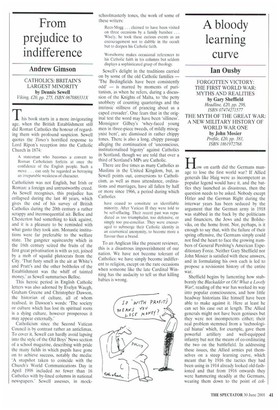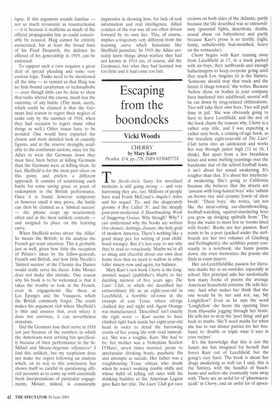A bloody learning curve
Ian Ousby
FORGOTTEN VICTORY: THE FIRST WORLD WAR: MYTHS AND REALITIES by Gary Sheffield Headline, £20, pp. 298, ISBN 07474271577 THE MYTH OF THE GREAT WAR: A NEW MILITARY HISTORY OF WORLD WAR ONE by John Mosier Profile, £20, pp. 381, ISBN 1861972768 How on earth did the Germans manage to lose the first world war? If Allied generals like Haig were as incompetent as popular legend would have it, and the battles they launched as disastrous, then the question needs to be asked. Nobody except Hitler and the German Right during the interwar years has been seduced by the argument that the German army in 1918 was stabbed in the back by the politicians and financiers, the Jews and the Bolsheviks, on the home front. Nor, perhaps, is it enough to say that, with the failure of their spring offensive, the Germans simply could not find the heart to face the growing numbers of General Pershing's American Expeditionary Force. Neither Gary Sheffield nor John Mosier is satisfied with these answers, and in formulating his own each is led to propose a revisionist history of the entire war.
Sheffield begins by lamenting how stubbornly the Blackadder or Oh! What a Lovely War!, reading of the war has worked its way into popular consciousness, and how little headway historians like himself have been able to make against it. Here at least he can set his case out at length. The Allied generals might not have been geniuses but they were not incompetents either; their real problem stemmed from a 'technological hiatus' which, for example, gave them powerful artillery and well-equipped infantry but not the means of co-ordinating the two on the battlefield. In addressing these issues, the Allied armies put themselves on a steep learning curve, which meant that by 1916 the tactics they had been using in 1914 already looked old-fashioned and that from 1916 onwards they were hammering steadily at the Germans, wearing them down to the point of col lapse. If this argument sounds familiar — not so much revisionist as resurrectionist — it is because it reaffirms as much of the official propagandist line as could conceivably be rescued. Haig cannot be entirely exonerated, but at least the broad lines of his Final Despatch, the defence he offered of his generalship in 1919, can be endorsed.
To support such a view requires a great deal of special pleading and some very curious logic. Tanks need to be mentioned all the time — to remind us that Haig was no hide-bound cavalryman or technophobe — even though little can be done to show that tanks altered the course, much less the outcome, of any battle. (The most, surely, which could be claimed is that the Germans had reason to regret their neglect of tanks only by the summer of 1918, when they had occasion to regret many other things as well) Other issues have to be avoided. One would have expected the closest and most detailed look at casualty figures, and at the reserve strengths available to the combatant nations, since for the Allies to wear the Germans down they must have been better at killing Germans than the Germans were at killing them. In fact, Sheffield is for the most part silent on this point, and prefers a different approach. It consists of scrutinising each battle for some saving grace or point of redemption in the British performance. Once it is found, however temporary or however small it may prove, the battle can then be claimed as a 'limited success' — the phrase crops up wearisomely often and in the most unlikely contexts — and assigned its place on the learning curve.
When Sheffield writes about 'the Allies' he means the British; in his analysis the French get scant attention. This is probably just as well, given how little the reception of Petain's ideas by his fellow-generals, French and British, and how little Nivelle's 'limited success' at the Chemin des Dames would really serve his thesis. John Mosier does not make this mistake. One reason why his book is to be welcomed is that it takes the trouble to look at the French, even in engagements like those at Les Eparges and the Vauquois, which the British commonly forget. The result makes his argument rich where Sheffield's is thin and ensures that, even where it does not convince, it can nevertheless stimulate.
Did the Germans lose their nerve in 1918 not just because of the numbers in which the Americans were arriving but specifically because of their performance in the StMihiel and Meuse-Argonne offensives? I find this unlikely, but my scepticism does not make me regret following an analysis which, on its way to this conclusion, has shown itself so careful in questioning official accounts as to come up with essentially fresh interpretations of particular engagements. Mosier, indeed, is consistently impressive in showing how, for lack of real information and real intelligence, Allied conduct of the war was all too often driven forward by its own lies. This, of course, implies a trajectory very different from the learning curve which historians like Sheffield postulate. In 1918 the Allies certainly knew things about warfare they had not known in 1914 (so, of course, did the Germans), but what they had learned was too little and it had come too late.











































































 Previous page
Previous page